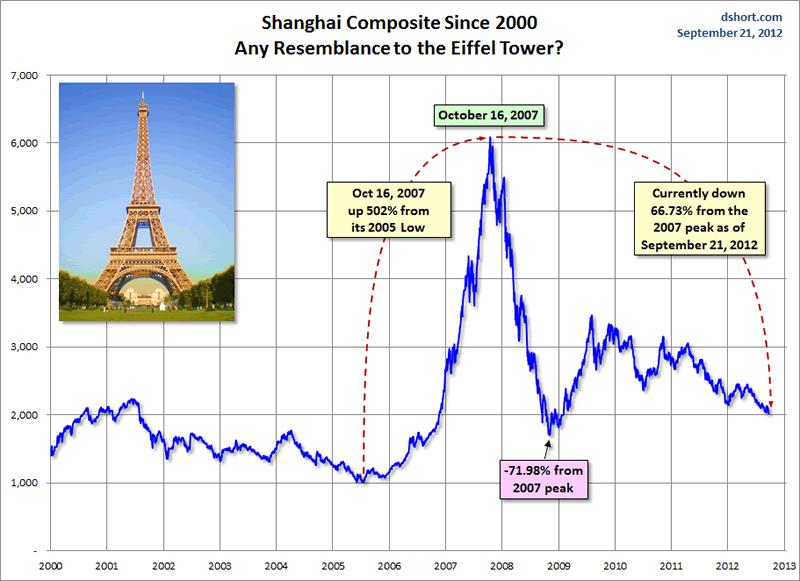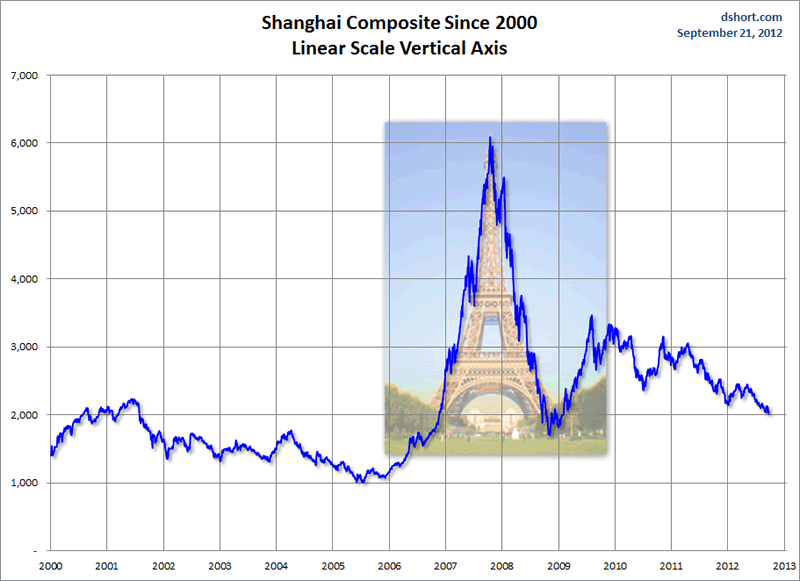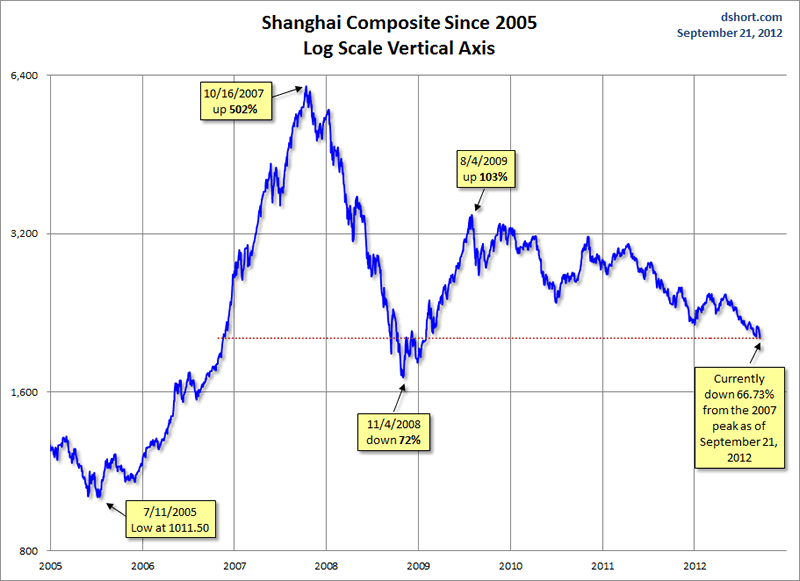China Stock Market Shanghai Tower Pattern and Aftermath
Stock-Markets / Chinese Stock Market Sep 23, 2012 - 12:49 PM GMTBy: PhilStockWorld
 Courtesy of Doug Short. : Of late market watchers in the U.S. are wondering if the QE3 stimulus will have a comparable effect on markets as the first two rounds of easing. And of course we in the US are nearing the end of the third quarter with earnings season just over the horizon. Around the world the ongoing euro zone financial crisis remains in the center circle of the world’s financial circus. But what caught my eye this afternoon in doing my weekly world market update was the ghastly performance of Shanghai Composite.
Courtesy of Doug Short. : Of late market watchers in the U.S. are wondering if the QE3 stimulus will have a comparable effect on markets as the first two rounds of easing. And of course we in the US are nearing the end of the third quarter with earnings season just over the horizon. Around the world the ongoing euro zone financial crisis remains in the center circle of the world’s financial circus. But what caught my eye this afternoon in doing my weekly world market update was the ghastly performance of Shanghai Composite.
My friend and occasional guest contributor Chris Kimble came up with the notion of an Eiffel Tower formation as an emblematic way to discuss asset bubbles, which was featured in a guest commentary from last summer. The behavior of the Shanghai index over a two-year period beginning in late 2006 is a classic example, as the first two charts illustrate.

With an arithmetic vertical axis, the Eiffel analogy is rather amazing.

But let’s switch to a log scale vertical axis and shorten the timeframe to look at the numbers. We diminish the playful tower analogy, but we get a more accurate visual representation of the relative values of peaks and troughs in the price.

The horizontal red line shows the current level of the index. At Friday’s close the index is down 7.85% year-to-date and over 66% off its 2007 all-time high.
Where is this index headed in the near to intermediate term? The ongoing economic turmoil in the eurozone, China’s biggest export market, continues to be a significant problem, and signs of a slowing domestic economy are exacerbating the problem. However, over the next few years, Chinese demographics should provide a bit of cushion.

In developed countries, the peak earning years are ages 45-54, with the 45-49 cohort as the peak spenders. Assuming China is moving toward a similar pattern (an assumption I make with caution), the earning-spending cohorts will grow significantly. Unless China’s housing bubble triggers a widespread retrenchment and a loss of consumer confidence, demographics, at least over the next 5-10 years, should work in China’s favor, driven by home-grown consumption.
One thing is certain. We’ll want to keep a close eye on the Shanghai Composite in the months ahead.
- Phil
Philip R. Davis is a founder of Phil's Stock World (www.philstockworld.com), a stock and options trading site that teaches the art of options trading to newcomers and devises advanced strategies for expert traders. Mr. Davis is a serial entrepreneur, having founded software company Accu-Title, a real estate title insurance software solution, and is also the President of the Delphi Consulting Corp., an M&A consulting firm that helps large and small companies obtain funding and close deals. He was also the founder of Accu-Search, a property data corporation that was sold to DataTrace in 2004 and Personality Plus, a precursor to eHarmony.com. Phil was a former editor of a UMass/Amherst humor magazine and it shows in his writing -- which is filled with colorful commentary along with very specific ideas on stock option purchases (Phil rarely holds actual stocks). Visit: Phil's Stock World (www.philstockworld.com)
© 2012 Copyright PhilStockWorld - All Rights Reserved Disclaimer: The above is a matter of opinion provided for general information purposes only and is not intended as investment advice. Information and analysis above are derived from sources and utilising methods believed to be reliable, but we cannot accept responsibility for any losses you may incur as a result of this analysis. Individuals should consult with their personal financial advisors.
© 2005-2022 http://www.MarketOracle.co.uk - The Market Oracle is a FREE Daily Financial Markets Analysis & Forecasting online publication.



